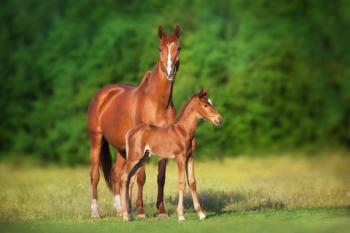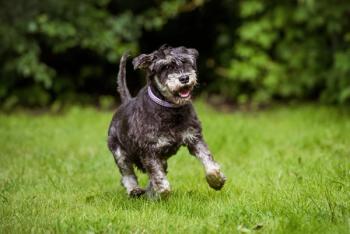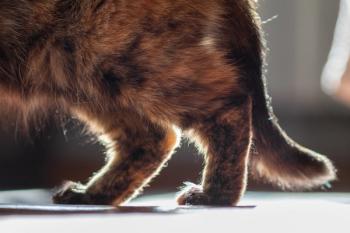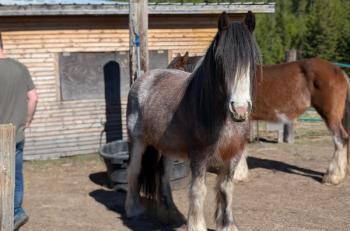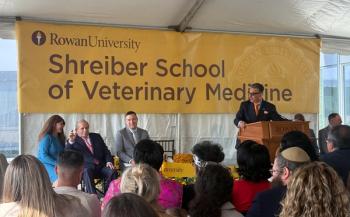
A pioneering vision for equine orthopedic research
C. Wayne McIlwraith looks back on a veterinary career dedicated to studying and fixing equine joints.
C. Wayne McIlwraith, BVSc, MS, PhD, DSc, FRCVS, DACVS, DECVS, DACVSMR, is a university distinguished professor, Barbara Cox Anthony University Endowed Chair in Orthopedics, and director of the Orthopedic Research Center at Colorado State University's College of Veterinary Medicine and Biomedical Sciences. Photos courtesy of Dr. C. Wayne McIlwraith, Colorado State University.The name C. Wayne McIlwraith may be familiar to you. Co-author of six textbooks, along with more than 400 textbook chapters and refereed publications, McIlwraith has also given approximately 600 presentations and workshops during his long and distinguished career in veterinary academia, where his research grants have totaled more than $21 million.
McIlwraith, BVSc, PhD, DSc, is chair of orthopedics and director of the Orthopedic Research Center at Colorado State University's (CSU) College of Veterinary Medicine and Biomedical Sciences. An award-winning academician and equine surgeon, he is one of the pioneers in some of the orthopedic practices widely used by today's veterinarians, and his research into joint disease is world-renowned.
While he has been working at CSU for the past 35 years, his climb to the top of his profession actually started on the other side of the globe.
From the mountains of New Zealand
Raised in the town of Oamaru on the South Island of New Zealand, McIlwraith spent his childhood among horses. “I didn't have a horse, but my uncle and aunt had a high-country sheep station, and I used to ride horses there,” he recalls. “My aunt was also into show jumping and taught me to ride.”
He also became fascinated with horseracing. “Since it was considered a gambling sport, my mother didn't approve of it, but I sneaked up to the racetrack on my bicycle just to look at the horses,” McIlwraith says.
Instead of medical school, McIlwraith at the last minute decided to pursue a career in veterinary medicine at Massey University. After earning his BVSc in 1970, he spent two years in a mixed country practice in New Zealand. About that same time he developed a passion for alpine climbing, and in 1973 he led an expedition to the Andes in South America.
McIlwraith then moved to England. Always interested in veterinary surgery, he worked at T.G. Yarrow, Forest Gate, London, a small animal practice that performed many surgeries. At the time, he recalls, veterinary surgeons were just beginning to successfully perform surgery to relieve colic in horses.
Just before Christmas 1973, McIlwraith met a veterinarian who would influence his career dramatically. His London mentor described training programs where one did a clinical specialty, internship and residency. “He called me on New Year's Day, 1974, and said I've got an application form for an internship at the University of Guelph's School of Veterinary Medicine,” McIlwraith says.
Though the application deadline was January 1, administrators at the Ontario college waited for McIlwraith's application. They were offering two large animal surgery internships, and McIlwraith secured one of the slots. (The other went to James Moore, DVM, now at the University of Georgia's College of Veterinary Medicine.) The two headed to Guelph.
McIlwraith performing arthroscopic surgery for osteochondritis dissecans of a femoropatellar joint.“We were taught a great deal by a number of people, including Rich Owen, Don Horney and Frank Milne,” McIlwraith says. “I was hooked. I knew what I wanted to do-equine surgery.” The focus on orthopedics would come later.
To the plains of America
After his internship, McIlwraith secured a surgical residency at Purdue's School of Veterinary Medicine. Seeing Indiana for the first time, McIlwraith, still an avid mountain climber, was startled at the flatness of the American Midwest. But the residency, he says, was exciting. He was given a research project on joint disease: arthritis in the horse. “That project became pivotal to me,” McIlwraith says. “As I did this project for my master's thesis, I read about the arthroscope. I thought this would be a good way to follow the synovitis [inflammation] we were creating in the joint.”
About that time, McIlwraith learned that orthopedic surgeon Lanny Johnson, MD, was giving a course at Michigan State's medical school on diagnostic arthroscopic surgery of the human knee, a procedure still in its infancy. “I called him to say I was a veterinary surgery resident, but I'd like to come to his course. He said, ‘I'd love to have you, won't charge you registration, and come on up.' I learned how to do diagnostic arthroscopy of the human knee along with the orthopedic surgeons taking the course. At that stage they didn't have MRI, and surgical procedures were done through arthrotomy based on clinical symptoms alone. After that, Purdue bought an arthroscope, and as a resident, I started doing diagnostic arthroscopy on equine knee joints.”
McIlwraith's career ultimately diverged along two complementary pathways. First, he worked on developing arthroscopic techniques in equine joints using clinical cases while he was at Purdue. Second, Dr. David Van Sickle, a joint researcher working with both dogs and humans, invited McIlwraith to pursue a PhD. “I saw a great opportunity, as there was very little literature in joint disease in horses, and none in arthroscopic surgery,” McIlwraith says.
He and Van Sickle demonstrated that synovitis alone, without any instability, could produce osteoarthritic change. At that time the literature discussed osteoarthritis as an iatrogenic condition in humans in which inflammation was produced secondarily by debris from the worn cartilage (often associated with instability).
“We showed that if you take a normal, intact joint and create inflammation, you'll get early osteoarthritis and loss of articular cartilage,” McIlwraith says. That set him on the research pathway of joint disease.
Home in the Rockies
McIlwraith was due to finish his PhD in 1979 and was considering moving back to the mountains of New Zealand when he got a call to interview at Colorado State University. Thirty-five years later, he's still there-in veterinary academia and in the mountainous terrain he loves.
Drs. McIlwraith and Valerie Moorman doing arthroscopic surgery on a traumatic injury to the medial femorotibial joint.For the first 15 years at CSU he worked primarily as a surgeon in the clinic, doing various types of surgery but focusing especially on equine arthroscopic surgery. His colleague Simon Turner was also doing arthroscopic surgery. “Simon and I cowrote two textbooks, one on basic techniques in large animal surgery and one on advanced techniques in equine surgery,” McIlwraith says. “He was a critical partner in those early years. We started seeing arthroscopic surgery cases from the 10 surrounding states, as we were the only institution doing it at that time.” Indeed, he recalls having a large caseload: 400 to 500 a year.
McIlwraith also taught courses in arthroscopic surgery, first at CSU and then in Orange County, California, where he met his wife, Nancy Goodman, DVM. (McIlwraith retains a private referral practice in California.) Soon he was being called overseas, by clients in France, England and Ireland, to perform surgeries. In 1984 he traveled to Miami to operate on Spend A Buck, who went on to win the 1985 Kentucky Derby by six lengths. McIlwraith believes his work on the equine champion helped boost the credibility of arthroscopic surgery among trainers, owners and veterinarians.
Working with surgical residents at CSU, he continued developing arthroscopic techniques in other joints. “In 1984, there was demand for the diagrams and pictures we used in the training courses, so I published them in the first edition of the book Diagnostic and Surgical Arthroscopy in the Horse,” McIlwraith says. The book is now in its fourth edition.
Mission: Develop the best orthopedic research center in the world
Also in 1984, McIlwraith started the Orthopedic Research Center at CSU. At first the research initiatives were small in scale, because McIlwraith was spending most of his time working in the clinic. But he had several promising graduate students, including Chris Kawcak and David Frisbie, who started a small biochemistry laboratory for joints.
In 1994, Jim Voss, then dean of CSU's College of Veterinary Medicine, asked McIlwraith to take over the equine science program, which included the equine reproductive laboratory, the equine science program and the growing Orthopedic Research Center.
“He wanted me to develop the best orthopedic research center in the world, and he gave me tools to potentially achieve that. He gave me a tenure-track research position, as well as a research technician and an assistant, and that's when the program started growing,” says McIlwraith.
The center received funding from the Stavros Niarchos Foundation, for which McIlwraith still consults today. Other donations started coming in as well.
From that trio of Kawcak, Frisbie and McIlwraith, the center has certainly grown. Today it includes 15 faculty members; a team of research associates, including a clinical trials manager and a laboratory manager; residents in both surgery and sports medicine; and veterinary students, graduate and undergraduate students. Moreover, funding from equine extramural sources-and, more recently, human industry and the National Institutes of Health (NIH)-have followed. The center also has added a new sports medicine program, as well as and the first residency in equine sports medicine and rehabilitation. “Certainly what the research center has evolved into makes me proud, but we've still got to keep moving forward,” McIlwraith says.
The Institute of Biologic Translational Therapies
The center has become one of the premiere equine orthopedic research centers in the world. Now it has an opportunity to progress to a whole new level.
“We've done quite a bit of work translatable to human medicine, with both industry and NIH grants, using our equine cartilage repair models,” McIlwraith explains. A recent and generous gift from John and Leslie Malone undoubtedly will help. (John Malone is the billionaire chairman of Liberty Media Corp. Leslie Malone is a major supporter of the U.S. Olympic Dressage Team.) The Malones support a position in the new specialty of equine sports medicine and rehabilitation. And John Malone is interested in stem cell therapy, which fostered the idea of the Institute of Biologic Translational Therapy-“with translation to equine musculoskeletal problems and to human musculoskeletal problems,” explains McIlwraith.
Recognition for a lifetime of achievements
Over the years, McIlwraith's work has garnered widespread recognition. For example, he was inducted into the University of Kentucky's Equine Research Hall of Fame, and he has received several prestigious awards, including:
Founders Award for Career Achievement from the American College of Veterinary Surgeons
Eclipse Award from the National Thoroughbred Racing Association
Markowitz Award from the Academy of Surgical Research
Marshall R. Urist, MD, Award from the Orthopedic Research Society
American Association of Equine Practitioners Distinguished Life Member.
The research will focus on the continued development of biologic therapies, including stem cells, platelet-rich plasma and autologous conditioned serum (IRAP used clinically in horses). The plan is to build a $65 million, 100,000-square-foot building to conduct research and teach courses in biology and biochemistry. “The new institute will allow us to do more with not only equine practitioners, but with human physicians and orthopedic surgeons, primarily in musculoskeletal work, our forte,” states McIlwraith.
The new institute will be a part of the Orthopedic Research Center, and it will be adjacent to the new Equine Veterinary Teaching Hospital, as well as other additions being developed. “There are plans to have a new relationship with the Western Stock Show Center in Denver, and part of it will be a new sports medicine and rehabilitation clinic under the auspices of CSU,” McIlwraith says. “To further our work in human translational research, we have a number of MD orthopedic surgeons and researchers committed to being part of the new institute. We also have had a number of great collaborations in human orthopedic research with the University of Pittsburgh, MIT, Stanford University and Indiana University.”
McIlwraith has spent his entire career helping and healing horses, and now with the help from some very generous horse-interested donors, the challenge to make CSU's Orthopedic Research Center the finest in the world will become a lifelong reality.
Not a bad ride for that boy who developed his love of horses on his uncle's New Zealand farm those many years ago.
Ed Kane, PhD, is a researcher and consultant in animal nutrition. He is an author and editor on nutrition, physiology and veterinary medicine with a background in horses, pets and livestock. Kane is based in Seattle.
Newsletter
From exam room tips to practice management insights, get trusted veterinary news delivered straight to your inbox—subscribe to dvm360.


